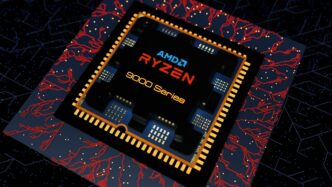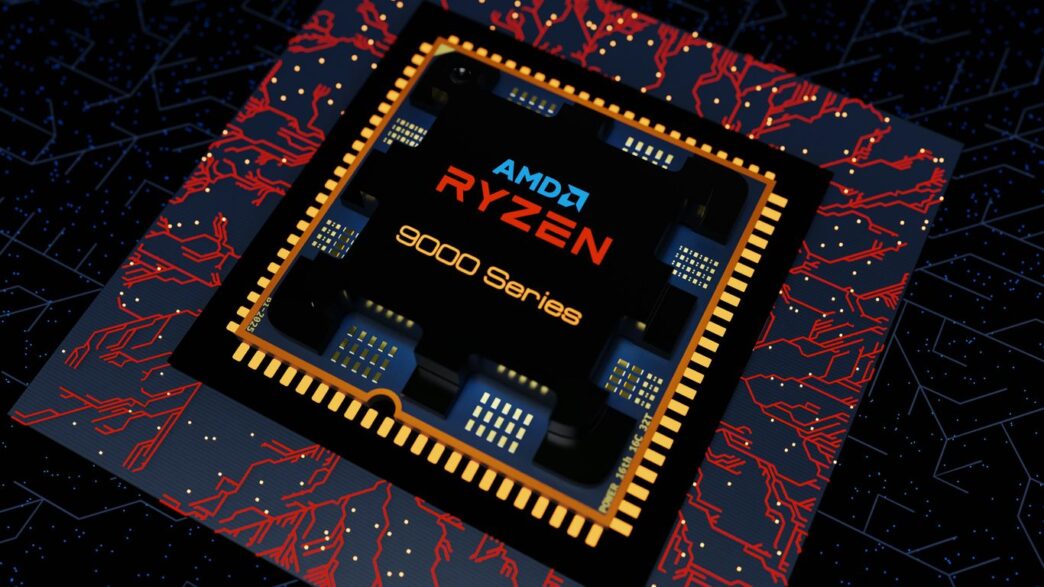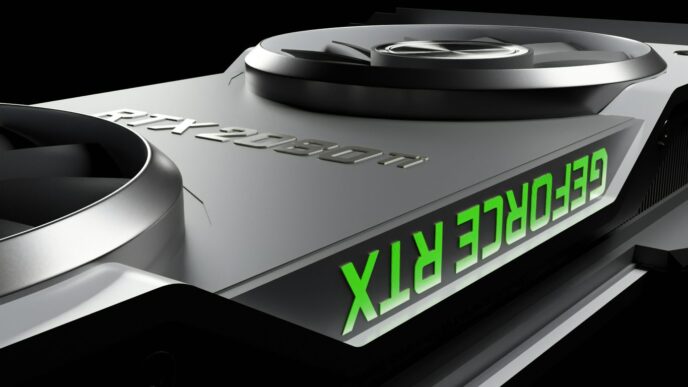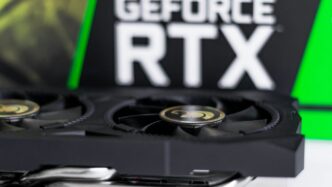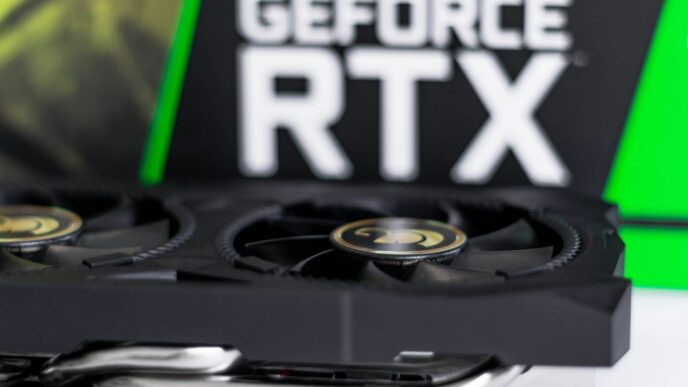So, AMD dropped a new chip, the Ryzen 9 9950X3D, and everyone’s talking about it. They’re saying it’s a big deal for both folks who game a lot and people who make stuff, like videos or 3D models. It’s supposed to be super fast, building on what they did before with that 3D V-Cache thing. Usually, you have to pick if you want a CPU that’s great for games or one that’s good for work, but this one might just do both really well. It’s got a lot of cores and some fancy tech, so it’s definitely worth a look if you need a powerful computer. We’re going to break down what this 9950X3D review is all about, looking at how it performs and what it means for your setup.
Key Takeaways
- The Ryzen 9 9950X3D uses a second-generation 3D V-Cache, which really helps speed things up by making the CPU access data faster.
- This new chip is designed to be good at both playing games and handling tough creative tasks, unlike some older processors.
- It uses the Zen 5 architecture and has a different way of placing the cache, which helps it run cooler and even allows for overclocking, something new for X3D chips.
- The 9950X3D fits into the existing AM5 platform and supports DDR5 memory and PCIe 5.0, making it compatible with current motherboards and devices.
- While it’s a powerhouse, its higher power needs mean you’ll need a good cooling setup, and it’s generally aimed at users who need top performance for both gaming and work, not just one or the other.
Unveiling the Ryzen 9 9950X3D: A Gaming Powerhouse
Alright, let’s talk about the new AMD Ryzen 9 9950X3D. This chip is kind of a big deal, especially if you spend most of your computer time playing games. AMD has been doing some really interesting things with their processors lately, and this one feels like they’re really trying to hit it out of the park for gamers.
Second-Generation 3D V-Cache: A Technological Breakthrough
So, what’s the big deal with this "3D V-Cache" thing? Basically, it’s like giving the CPU a much bigger, faster scratchpad to work with. Imagine you’re cooking and have all your ingredients right next to you on the counter instead of having to walk to the pantry every time you need something. That’s kind of what this cache does for the processor. AMD’s second-generation version of this tech is even better. It means the CPU can grab the data it needs way quicker, which is super important for games that are constantly loading new stuff. This reduction in waiting time is a major reason why games just feel smoother and run faster.
Architectural Innovations and Technological Advantages
Beyond just the cache, AMD has tweaked the insides of the 9950X3D. They’re using their new Zen 5 architecture, which is supposed to be more efficient and powerful. When you combine that with the improved cache, you get a CPU that’s really good at handling all the complex calculations games throw at it. It’s not just about raw speed; it’s about how smartly the processor works. Think of it like a really organized chef who can prep multiple dishes at once without getting flustered. This processor is designed to keep up with the demands of modern gaming, where frame rates and responsiveness are key.
Gaming Performance: A New Standard in PC Gaming
When it comes to actual gameplay, the 9950X3D really shines. We’re seeing some seriously impressive numbers in popular games. Whether you’re playing fast-paced shooters or big open-world adventures, this CPU helps push frame rates higher and keeps things from stuttering. It’s not just a small bump either; in many cases, it sets a new bar for what we expect from a gaming CPU.
Here’s a quick look at how it stacks up in some common scenarios:
- High Refresh Rate Gaming: Expect to hit those 144Hz and even 240Hz targets more consistently in competitive titles.
- Demanding AAA Titles: Games with lots of detail and complex environments will run noticeably smoother, especially at higher resolutions.
- Reduced Load Times: Games that rely heavily on asset streaming will benefit from the faster cache access.
While it’s a powerhouse for gaming, it’s also worth noting that the performance gains can vary a bit depending on the specific game and how it’s designed. But overall, for anyone building a new high-end gaming rig, the 9950X3D is definitely a top contender.
Professional Workloads: Creator-Focused Performance
While the Ryzen 9 9950X3D is a beast for gaming, it’s not just a one-trick pony. This processor is seriously built for folks who create stuff for a living, too. Think video editors, 3D modelers, graphic designers – anyone who pushes their computer hard with complex software.
Creator-Focused Performance Enhancements
This chip packs a serious punch when it comes to creative tasks. With its 16 cores and high clock speeds, it chews through demanding jobs like video editing, rendering 3D scenes, and heavy photo manipulation. You’ll notice a real difference in how quickly your projects get done compared to older processors. The extra cores and smart architecture mean less waiting around and more doing.
Productivity Applications: Beyond Gaming
So, what does this mean in practice? Well, if you’re working with large video files, juggling tons of layers in Photoshop, or waiting for complex renders to finish, the 9950X3D can cut down those times significantly. It’s not just about gaming frames per second; it’s about getting your work completed faster, which translates directly into more productivity and less frustration. Different programs use these cores in their own ways, so the exact speed-up can change depending on what you’re running.
Multi-Threaded Performance Advantages
Here’s a quick look at how it stacks up in some common creator scenarios:
- Video Editing: Expect smoother playback and faster export times, especially with high-resolution footage.
- 3D Rendering: Complex scenes that used to take hours might now take considerably less time, thanks to all those cores working together.
- Software Development: Compiling large codebases will also see a noticeable speed improvement.
Basically, if your workflow involves tasks that can spread out across many processor cores, the 9950X3D is designed to handle it with gusto.
Architectural Design and Technological Advancements
Alright, let’s talk about what makes the Ryzen 9 9950X3D tick. It’s not just about slapping more cores on a chip; AMD has been doing some clever engineering here.
Zen 5 Architecture and Manufacturing Process
The heart of this beast is the Zen 5 architecture. This isn’t just a minor tweak from Zen 4. AMD has refined the core design itself, aiming for better instructions per clock cycle and generally making things run smoother. They’re also using an updated manufacturing process, which usually means better efficiency and the ability to push clock speeds a bit higher without melting everything down. Think of it like a more efficient engine in a car – it can go faster and use less fuel.
Dual-CCD vs. Single-CCD Configurations
Now, this is where things get interesting for the 9950X3D. Unlike some other Ryzen chips that might use a single block of cores (a CCD), this one uses two. This setup allows AMD to pack in more cores overall. For the 9950X3D, they’ve strategically placed the 3D V-Cache on one of these CCDs. This means you get the massive cache benefit for certain tasks, like gaming, while the other CCD can focus on raw processing power for things like rendering or compiling code. It’s a bit of a hybrid approach, trying to get the best of both worlds.
Revolutionary Cache Placement for Overclocking
Speaking of that 3D V-Cache, its placement is pretty neat. By stacking it vertically, AMD drastically cuts down the time it takes for the processor to grab frequently used data. This is a huge deal for games, which often need quick access to lots of information. For overclocking, this setup presents some unique challenges and opportunities. While the cache itself isn’t typically the part you’d overclock directly, its presence and the way it interacts with the cores can affect how high you can push the overall clock speeds. You might find that certain cores or CCDs behave differently when you start messing with voltages and frequencies. It’s a different ballgame compared to CPUs without this stacked cache technology.
Platform Support and Connectivity
So, you’ve got this beast of a CPU, the Ryzen 9 9950X3D, and you’re wondering what kind of motherboard and other bits and bobs you’ll need to make it all work. Don’t sweat it, it’s pretty straightforward.
AM5 Socket Compatibility
First things first, this chip is built for the AM5 socket. That means you’ll need a motherboard that supports AM5. AMD has been pretty good about sticking with sockets for a while, so if you’re upgrading from an older AM4 system, you’ll definitely need a new board. But hey, AM5 is where all the new tech is at, so it’s a good move. You can find some solid options out there, like the ASUS ROG Strix X870E if you want a quick recommendation.
DDR5 Memory Support and EXPO Technology
Forget about your old DDR4 sticks; the 9950X3D is all about DDR5. This new memory standard is faster and more efficient, which is exactly what you want for a high-end processor. AMD also has its own thing called EXPO (Extended Profiles for Overclocking). It’s basically like Intel’s XMP, letting you easily set your RAM to its advertised speeds without fiddling around in the BIOS for hours. Just make sure you grab a DDR5 kit that’s compatible with EXPO for the best experience.
PCIe 5.0 Lanes and Storage Options
When it comes to speed, the 9950X3D is ready for the latest and greatest. It supports PCIe 5.0, which is double the bandwidth of PCIe 4.0. This is great news for your graphics card, giving it more room to breathe, and even better for super-fast NVMe SSDs. You’ll be able to get storage that loads games and applications in the blink of an eye. Motherboards will vary in how many PCIe 5.0 lanes they offer for M.2 slots versus the main GPU slot, so check the specs if you plan on running multiple Gen 5 devices.
Here’s a quick rundown of what to expect:
- Graphics Card Slot: Typically PCIe 5.0 x16, giving your GPU all the bandwidth it needs.
- M.2 Slots: You’ll find boards with PCIe 5.0 M.2 slots for the absolute fastest storage. Some might offer PCIe 4.0 for secondary drives.
- Chipset Features: The motherboard chipset (like X870 or B850) will determine the total number of PCIe lanes and other connectivity options, such as USB ports and Wi-Fi.
Basically, the platform is built for speed and future-proofing, so you can be sure your new CPU will have plenty of fast connections to work with.
Power Consumption, Efficiency, and Cooling Considerations

Alright, let’s talk about what keeps this beast running and how to keep it from getting too hot under the collar. The Ryzen 9 9950X3D, with all its cores and that fancy 3D V-Cache, definitely draws more power than its less-endowed siblings, especially when you’re really pushing it with demanding tasks. We’re talking about a noticeable jump in wattage compared to something like the Ryzen 7 9800X3D, particularly during heavy AVX workloads or intense multi-threaded rendering sessions. This higher power draw isn’t just a number; it means you’ll need a more robust cooling solution to keep things stable and performing at their peak.
TDP and Power Demands
The Thermal Design Power (TDP) gives us a general idea, but the real-world power draw under load is where things get interesting. While the 9950X3D has a higher TDP, its peak power consumption can be significantly higher, sometimes by over 25% in stress tests compared to the 9800X3D. This means that while idle power might be relatively close, heavy lifting is where the 9950X3D really flexes its energy needs. It’s not just about gaming here; creators pushing rendering or complex simulations will see this power draw climb.
Cooling Solutions for Optimal Performance
Because of that increased power draw, cooling is not optional; it’s a necessity. For the 9950X3D, a high-end cooler is strongly recommended. We’re looking at something like a 360mm AIO liquid cooler to effectively dissipate the heat generated during sustained heavy loads. Trying to get by with a basic air cooler might lead to thermal throttling, meaning the CPU will slow itself down to prevent overheating, which defeats the purpose of having such a powerful chip. A good cooler ensures you can actually use all those cores at their intended speeds for longer periods. For those interested in building a new system, checking out high-performance CPU coolers is a smart move.
Efficiency Compared to Predecessors
Now, here’s where it gets a bit nuanced. While the 9950X3D uses more power overall, it’s surprisingly efficient when you look at performance per watt, especially in multi-threaded tasks. Think of it like a big truck – it uses more fuel than a small car, but it can haul a much bigger load. For tasks that can utilize all those cores, the 9950X3D can actually complete the work using less energy overall compared to older generations or even some competitors, despite its higher peak consumption. This means for creators who need that raw multi-core throughput, the efficiency gains can justify the higher power budget, provided you have the cooling to match.
Ryzen 9 9950X3D vs. Ryzen 7 9800X3D: A Comparative Analysis
So, you’re looking at the new Ryzen 9000 series X3D chips and wondering, "Which one is right for me?" It’s a fair question, especially when you see two processors like the Ryzen 9 9950X3D and the Ryzen 7 9800X3D. They both have that fancy 3D V-Cache tech, but they’re aimed at pretty different people, and the price tags show it. Let’s break it down.
Target Audiences and Use Cases
The Ryzen 9 9950X3D is basically AMD’s "everything" chip. It’s got a ton of cores – 16 of them, to be exact – which makes it a beast for anyone doing serious work like video editing, 3D rendering, or running virtual machines. Gamers who also happen to be content creators or streamers will find a lot to like here. It’s for the person who wants the absolute best of both worlds and doesn’t mind paying a premium for it. Think of it as the ultimate all-rounder, but with a price tag to match.
On the flip side, the Ryzen 7 9800X3D is laser-focused. Its main gig is gaming, and it does it exceptionally well. With 8 cores, it’s more than enough for most games, and the 3D V-Cache really shines here, giving you those extra frames per second. This chip is for the gamer who wants top-tier performance without all the extra complexity and cost of a workstation-class CPU. If your PC is primarily for playing games, and maybe some light multitasking, the 9800X3D is probably your sweet spot.
Gaming Performance: A New Standard in PC Gaming
Here’s where things get interesting. For pure gaming, the difference between these two chips is often surprisingly small. In many titles, the 9800X3D can keep pace with, and sometimes even beat, the more expensive 9950X3D. This is largely thanks to how the 3D V-Cache is implemented and how games utilize the cores. The 9800X3D’s single-CCD design often means simpler scheduling for games, leading to smoother performance.
- Identical Top-Tier Gaming: Both processors deliver incredibly high frame rates, often within a few percent of each other in most gaming benchmarks.
- 9800X3D’s Simplicity: Its single-CCD design can sometimes offer a slight edge in gaming due to more straightforward core scheduling.
- 9950X3D’s Potential: While not always faster, the 9950X3D’s extra cores can be beneficial in games that heavily utilize more threads or in scenarios where you’re gaming and streaming simultaneously.
Productivity Applications: Beyond Gaming
This is where the 9950X3D really pulls ahead. That extra set of cores makes a massive difference in tasks that can use all those threads. If you’re compiling code, rendering video, or working with large datasets, the 9950X3D will finish those jobs significantly faster.
| Application Type | Ryzen 9 9950X3D Advantage | Ryzen 7 9800X3D Role |
|---|---|---|
| Video Editing | Significant Speedup | Capable, but slower |
| 3D Rendering | Much Faster | Basic Use Only |
| Software Compilation | Noticeably Quicker | Slower |
| Multi-tasking Heavy | Superior | Good |
Value Proposition and Pricing Strategy
Let’s talk money. The Ryzen 7 9800X3D typically comes in at a considerably lower price point than the 9950X3D. This makes it a much more attractive option for gamers who want maximum performance without breaking the bank. The money saved on the CPU can then be put towards a better graphics card, faster storage, or other components that can actually improve your gaming experience.
The 9950X3D, on the other hand, commands a premium. Its higher price is justified for professionals who can directly benefit from its increased multi-threaded performance. For them, the extra cost translates into saved time and increased productivity, which can be worth the investment. Ultimately, the 9800X3D is the clear winner for pure gaming value, while the 9950X3D is the choice for those who need a powerful all-around workstation that also excels at gaming.
So, Is the Ryzen 9 9950X3D Worth It?
Alright, let’s wrap this up. The AMD Ryzen 9 9950X3D is a seriously powerful chip, no doubt about it. For folks who absolutely need top-tier gaming performance and want to crunch through heavy creative work like video editing or 3D rendering without breaking a sweat, this CPU is a beast. It really does try to do it all. However, it comes with a pretty hefty price tag, and you’ll need to make sure the rest of your system can keep up, especially when it comes to cooling. If your main focus is just gaming, AMD’s own Ryzen 7 9800X3D often gets you most of the way there for less money and with less hassle. But if you’re a creator who also loves to game, and budget isn’t the biggest concern, the 9950X3D is a strong contender that won’t disappoint.
Frequently Asked Questions
What makes the Ryzen 9 9950X3D special for gaming?
The Ryzen 9 9950X3D has a special feature called 3D V-Cache. Think of it like a super-fast storage space right next to the computer’s brain (the CPU). This extra space holds game data that’s used a lot, so the CPU can grab it much quicker. This means games run smoother and faster, with fewer annoying pauses.
Can this processor help with tasks other than gaming, like making videos or art?
Yes, absolutely! Besides being great for games, the 9950X3D is also a powerhouse for creative work. It has a lot of processing cores, which are like tiny workers. Having many workers means it can handle tough jobs like editing videos, creating 3D models, or editing big photos much faster than older processors.
Is the 9950X3D hard to cool down?
While it’s a powerful chip, AMD has made improvements. The way the special cache is placed helps it run cooler than you might expect for its power. Still, for the best performance, especially if you push it hard, using a good cooler, like a liquid cooler, is a smart idea to keep things running smoothly.
Will this processor work with my current computer parts?
The 9950X3D uses the AM5 socket, which is AMD’s current platform. This means it should work with motherboards designed for AM5. It also uses the newer DDR5 memory, which is faster than older types. Always check your motherboard’s compatibility list to be sure.
How is the 9950X3D different from the 9800X3D?
The main difference is that the 9950X3D has more cores (16) and is designed for both top-tier gaming and heavy creative work. The 9800X3D has fewer cores (8) but is purely focused on being the best gaming CPU possible, often at a lower price and using less power. For just gaming, the 9800X3D is often just as good, but the 9950X3D is better if you do a lot of other demanding tasks too.
Does the 3D V-Cache technology mean it uses more power?
While adding more cache can sometimes increase power needs, AMD has worked hard to make this technology efficient. The 9950X3D has a specific power rating (TDP), and while it’s a high-performance chip, the 3D V-Cache is designed to boost speed without drastically increasing power consumption compared to its performance gains.

